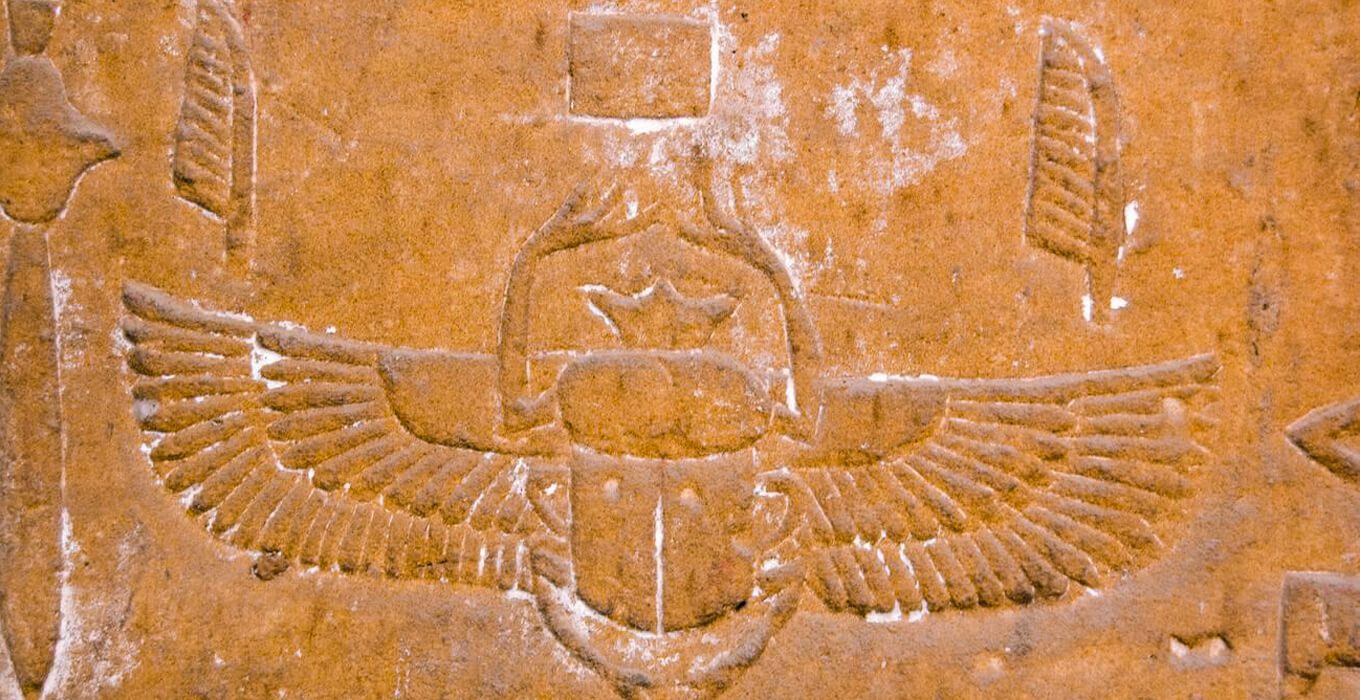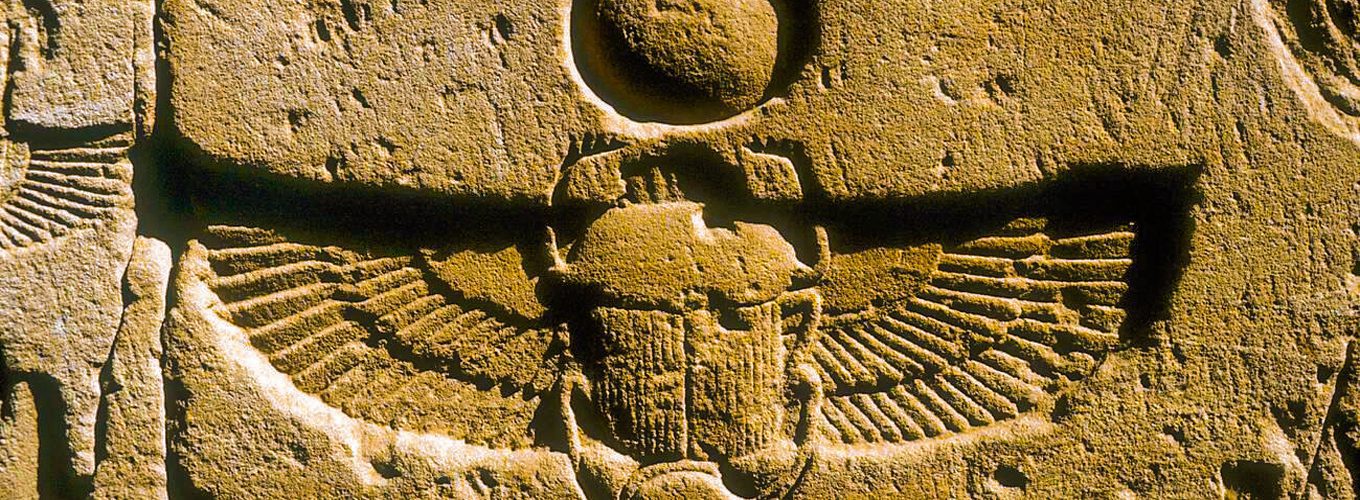Discover Egypt, you will indulge in the rich tapestry of ancient Egyptian symbolism, few motifs hold as much cultural and spiritual weight as the scarab beetle. Often referred to as “kheper,” this small yet potent creature carried profound significance in the hearts and minds of the Egyptians, symbolizing themes of transformation, life, and protection. In this exploration, we journey into the depths of the Scarab Beetle Meaning, unraveling its roles in religious iconography, funerary practices, and daily life.
Join us as we delve into the mystical world of the scarab beetle and unlock the hidden layers of symbolism that have transcended time.
Read our Fully Top 30 Ancient Egyptian Symbols and Meanings & Top 40 Ancient Egyptian Gods and Goddesses and Their Powers
The Egyptian Scarab Beetle and Scarab Symbol Meaning in Ancient Egypt
In ancient Egypt, The Egyptian Scarab Beetle held deep symbolic meaning and played a significant role in various aspects of Egyptian culture, religion, and daily life. Here are some key meanings associated with the scarab beetle in ancient Egypt:
1- Symbol of Renewal and Rebirth
The scarab beetle was closely linked to the concept of renewal and rebirth. The Egyptians observed the beetle rolling balls of dung along the ground, symbolizing the sun’s daily journey across the sky—disappearing at night and reappearing in the morning. This behavior led to the association of the scarab with the cycle of life, death, and resurrection.
2- Representation of the Sun God Ra
The scarab became a symbol of the sun god Ra. The rolling of the dung ball was seen as parallel to Ra’s journey across the sky. As Ra was considered a symbol of creation and the life force, the scarab took on similar associations.
3- Protective Amulet
Scarabs were widely used as protective amulets and charms. Egyptians believed wearing or carrying a scarab could bring good luck, ward off evil, and protect the wearer from harm.
4- Funerary Symbolism
Scarabs were commonly placed among the wrappings of mummies or on the deceased’s chest in tombs. They were thought to assist the deceased in the afterlife, ensuring a safe journey and facilitating the process of rebirth.
5- Symbol of Transformation
The scarab’s life cycle, from its emergence as a larva from dung to its transformation into a beetle, symbolized transformation and metamorphosis. This process was a metaphor for the soul’s journey through life, death, and the afterlife.
6- Symbol of Eternal Life
The scarab was associated with the concept of eternal life. Its role in funerary practices and its connection to the sun’s daily renewal contributed to the belief in the continuity of life beyond death.
7- Seals and Inscriptions
Scarabs were used as seals, often inscribed with names, titles, or other symbols. These scarab seals were employed for various purposes, including marking ownership, providing protection, and serving as official insignia. Overall, the scarab beetle held a multifaceted and profound symbolism in ancient Egypt, encompassing life, death, rebirth, protection, and the eternal nature of existence. Its pervasive presence in Egyptian art, jewelry, and religious practices underscores its importance in ancient Egyptian civilization’s cultural and spiritual landscape.
Significance of the Egyptian Scarab Beetle Symbolism in Ancient Egypt
In ancient times, people thought that scarabs might assist deceased individuals on their trip to the afterlife and that they could guarantee a successful resurrection in the world that follows this one. When the ancient Egyptians mummified their deceased, they preserved the corpse but removed some of the internal organs but left the body intact.
Why was a scarab beetle buried with a mummy?

- The scarab beetle held significant symbolism in ancient Egyptian culture, and it was often associated with protection, regeneration, and rebirth. The beetle’s habit of laying its eggs in dung and the subsequent emergence of new life from this material made it a powerful symbol of transformation and resurrection.
- The ancient Egyptians believed in an afterlife, and the process of mummification and burial was intricately connected to their religious beliefs about the soul’s journey after death. Scarab beetles, commonly known as dung beetles, were linked to the sun god Ra and were considered guardians of the deceased.
- Scarabs were placed among the wrappings of mummies, or even on the heart, to provide protection and aid in the deceased’s journey through the afterlife. The idea was that the scarab beetle would guide and protect the soul, helping it to navigate the challenges it might encounter in the underworld and ensuring a successful passage to the afterlife.
- These scarabs often featured inscriptions or carvings with spells and prayers meant to invoke divine protection and assistance. The use of scarabs in burial practices allowed the ancient Egyptians to incorporate religious symbolism and beliefs into preparing and safeguarding the deceased for the journey into the next life.
Types of Ancient Egyptian Scarabs & Scarab Meaning Spiritual
In ancient Egypt, scarabs were crafted in various forms and designs, each with its specific purpose and symbolism. Here are some of the types of scarabs found in ancient Egyptian culture:
- Heart Scarabs: These scarabs were often placed on the deceased’s chest during mummification. They were believed to protect the heart, which was considered the seat of the soul. The scarab had inscriptions from the Book of the Dead or other protective spells.
- Funerary Scarabs: Designed for use in tombs and burials, funerary scarabs were placed with the deceased to ensure safe passage to the afterlife. They often featured inscriptions or depictions related to religious beliefs and rituals.
- Throne Name Scarabs: These scarabs featured the throne name of a pharaoh and were created to commemorate a specific ruler. They were often used as propaganda to promote the king’s legitimacy and power.
- Good Luck Scarabs: Scarabs were also crafted as amulets for good luck, protection, and prosperity. These scarabs were not necessarily associated with funerary practices but were worn or carried daily.
- Khepri Scarabs: Khepri was a form of the sun god Ra and was depicted as a scarab beetle pushing the sun across the sky. Scarabs associated with Khepri symbolized the creative and renewing powers of the sun.
- Wedding Scarabs: Scarabs were sometimes exchanged during weddings as symbols of protection, fertility, and the cyclical nature of life. They were often inscribed with wishes for a happy and prosperous marriage.
- Judicial Scarabs: These scarabs were used as seals for official documents and were often inscribed with the names of officials or rulers. They were impressed with clay or other materials to authenticate legal or administrative documents.
- Victory Scarabs: Created to commemorate military victories, these scarabs featured inscriptions and images related to successful military campaigns. They were often distributed as propaganda to boost the image of the ruling pharaoh.
- Name Scarabs: Scarabs with the names of individuals, often non-royal, were used as personal amulets or seals. They could represent the individual’s identity and were sometimes exchanged as gifts.
- Magical Scarabs: Some scarabs were created with magical or protective symbols, often associated with specific deities or religious beliefs. These scarabs were believed to have talismanic properties.
Facts About The Ancient Egyptian Scarab Beetle | Why do Egyptians like scarab beetles?
Forces and brought good luck to the wearer. They were commonly used in jewelry and as part of daily attire.
- Funerary Significance: Scarabs played a crucial role in funerary practices. Heart scarabs, for example, were placed on the chest of the deceased during mummification to ensure the heart’s protection in the afterlife.
- Variety of Materials: Scarabs were crafted from various materials, including stone, faience, and precious metals. The choice of material often depended on the individual’s social status and the intended use of the scarab.
- Inscriptions and Symbols: Many scarabs were inscribed with hieroglyphs or symbols representing prayers, spells, or personal messages. These inscriptions were believed to enhance the amulet’s protective and magical properties.
- Different Types: As mentioned earlier, scarabs come in various types, including heart scarabs, funerary scarabs, good luck scarabs, and others, each serving a specific purpose in religious, funerary, or daily life.
- Khepri and Transformation: The scarab beetle was associated with the god Khepri, a form of Ra representing the sunrise and the creative forces of transformation. This further emphasized the scarab’s symbolism of renewal and metamorphosis.
- Royal Connections: Scarabs were often used to commemorate royal events or promote a pharaoh’s legitimacy. Throne names, and scarabs, for example, featured the name of a ruler and were distributed as a form of propaganda.
- Archaeological Discoveries: Numerous scarabs have been found in archaeological excavations, often in tombs and burial sites. These artifacts provide valuable insights into ancient Egyptian beliefs, customs, and the status of individuals.
- Cultural Influence: The scarab beetle and its symbolism have impacted Egyptian art and culture. Scarabs continued to be used as decorative motifs in various forms of art and design throughout ancient Egyptian history.
- Time Period: The use of scarabs spans a long period in ancient Egyptian history, from the pre-dynastic period to the Ptolemaic and Roman periods. The significance of scarabs evolved, but they remained integral to Egyptian culture.
These facts highlight the multifaceted role of the scarab beetle in ancient Egyptian civilization, showcasing its importance in religious practices, funerary rituals, and everyday life.
What is the name of The Egyptian Scarab Beetle?
The Egyptian name for the scarab beetle is “kheper” or “xpr” in ancient Egyptian hieroglyphs. The word “kheper” is associated with transformation, creation, and renewal, reflecting the beetle’s symbolism in ancient Egyptian culture. The scarab beetle, particularly the dung beetle species, represented the sun’s daily journey and the cycle of life, death, and rebirth. The name “kheper” is closely linked to the god Khepri, a form of the sun god Ra, who was depicted as a scarab beetle pushing the sun across the sky.Do scarabs still exist?
Yes, scarab beetles still exist, and they are a diverse group of beetles belonging to the family Scarabaeidae. The scarab family is one of the largest and most diverse beetle families, with over 30,000 species worldwide. While the specific species revered by the ancient Egyptians for its symbolism, the dung beetle (Scarabaeus sacer), is found primarily in the Mediterranean region and parts of the Middle East, scarab beetles as a family are distributed globally.
How big are Egyptian scarab beetles?

The size of Egyptian scarab beetles can vary depending on the species. The scarab beetle associated with ancient Egyptian symbolism, Scarabaeus sacer, commonly known as the dung beetle, is typically about 15 to 30 millimeters (0.6 to 1.2 inches) long. This size range includes both males and females.
You can learn more about the history of ancient Egypt through our following article:
- Eye of Horus vs Eye of Ra
- Anubis Egyptian Dog God
- 42 Ancient Egyptian Amulets
- 30 Important Ancient Egyptian Symbols
- Top 5 Egyptian Symbols for Power
- Top 8 Egyptian Symbols for Strength
- Top 15 Ancient Egyptian Good Luck Symbols
- Top 28 Egyptian Symbols Of Protection
- Revered Animals in Ancient Egypt NYT
- List of 22 Ancient Egyptian Pharaohs
- Ancient Egyptian Goddess Bastet


